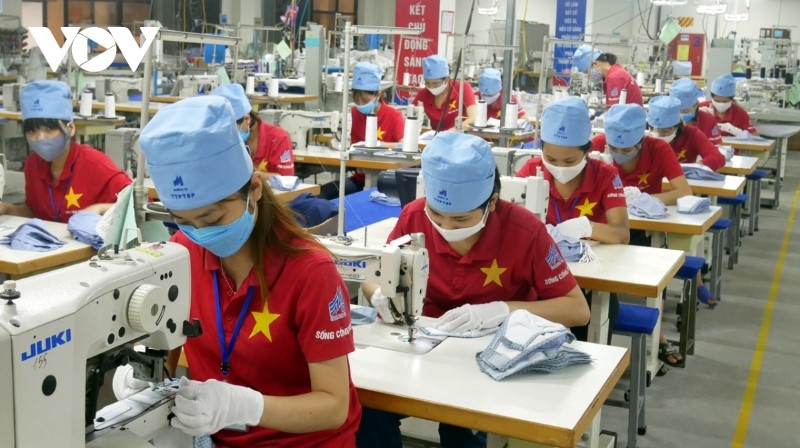Achieving 12% export growth in 2025 hinges on breakthrough solutions
VOV.VN - To achieve export growth of 10%-12% in 2025, businesses and experts underscore the need for technological innovation, digital transformation, diversification of trade promotion forms, and adoption of e-commerce channels.
The Ministry of Industry and Trade has set a target for this year's export growth of 10%-12% compared to 2024, with the trade surplus projected to exceed US$20 billion.
Exporting high value-added products
The year 2025 marks the beginning of a new term for the Board of Directors of the Vietnam National Textile and Garment Group (Vinatex), heralding a fresh chapter for the group. Vinatex forecasts that textile and garment export turnover will grow by 5%-6% this year, equivalent to an increase of US$45.5 billion to US$46 billion.
Cao Huu Hieu, General Director of Vinatex, stated that to achieve this key goal, the group will pursue sustainable development across the dimensions of the environment, society, governance, and finance. This strategic approach is expected to bolster Vietnam’s position in the global textile and garment supply chain.
He emphasized that the group will accelerate innovation in management methods through digital transformation, alongside adopting best practices in corporate governance.
“In 2025, Vinatex will continue to research and develop new products and niche markets to create its unique value,” Hieu affirmed.
Meanwhile, fruit and vegetable exports are set to surpass US$7 billion. To meet this ambitious goal, businesses must diversify their products while adhering strictly to quality standards, plant quarantine regulations, packaging requirements, and traceability rules.
Regarding the export potential for the Vietnamese fruit and vegetable sector in 2025, Dang Phuc Nguyen, General Secretary of the Vietnam Fruit and Vegetable Association (Vinafruit), highlighted that durian and passion fruit will remain Vietnam’s key export items. He added that China will continue to be the largest market for durian, while the EU is poised to remain the primary market for passion fruit.
“Farmers and businesses must prioritize product quality standards to maintain stability and ensure sustainable development,” Nguyen stressed. He also underlined the importance of building brands, developing human resources with professional qualifications, and improving foreign language skills, along with understanding the tastes and legal frameworks of export markets.
Flexibility key in adapting to market changes
Experts warn that Vietnamese exports face several risks in 2025, particularly as many export products still depend heavily on a few large markets.
Tran Thanh Hai, Deputy Director of the Import-Export Department, pointed out that these markets are likely to adjust their policies or experience economic fluctuations. Consequently, enterprises must adopt more effective market diversification strategies to maintain robust turnover.
He said that the department will strengthen research, forecasting, and warning systems for export products, providing timely updates on factors affecting the transportation, circulation, and trade of Vietnamese goods. The department also plans to collaborate with local authorities to promote border trade activities, transitioning them gradually to official trade channels, and support businesses in overcoming new trade barriers in import markets.
To meet economic growth targets, Vu Ba Phu, Director of the Trade Promotion Agency under the Ministry of Industry and Trade, stressed that in 2025, the agency will focus on diversifying markets and leveraging market-opening opportunities offered by FTAs to boost exports to major markets.
The agency’s priorities this year include developing markets for raw materials and products aligned with circular economy criteria. It also plans to promote trade for environmentally friendly products as a contribution to the green transition while helping businesses improve their competitiveness in the evolving global context and participate more deeply in the global value chain.
Phu added that the agency will enhance enterprise competitiveness through consulting programs that provide insights into market trends, changes in trade policies, regulations, and consumer preferences in import markets.



